Beyond Wild Expectations: The sky's the limit – how Upper West Side residents redefined urban gardening within their NYC rooftop oasis
A side step away from the bustling streets of Manhattan lies a quiet retreat on a garage rooftop. The Lotus Garden is the product of 28 gardeners, providing an abundant green escape beneath the skyscrapers


Nestled between Broadway and West End Avenue in New York City is an unassuming wrought iron gate you might miss if you blink as you hurry past. Behind, a long and narrow staircase leads to one of Manhattan's best kept secrets: a thriving rooftop oasis, nurtured by a network of dedicated gardeners.
'There are always new people discovering us. I lived in the neighborhood for decades without knowing it was here,' says Karen Gershenhorn, Co-President of The Lotus Garden. 'There's a lot of enthusiasm for it from the local community, which is delightful.'
Decades previous in the 1960s, The Lotus Garden's plot was home to two grand movie theaters, the Riverside and Riviera. When the buildings were eventually demolished, gardeners came together to create a guerrilla gardening space. But building plans were soon made for a new condo to go up, which sparked green-fingered activists Carrie Maher, a horticulturist, and Mark Greenwald, an architect, to fight for a garden to be installed on site and protect this wonderful community asset.
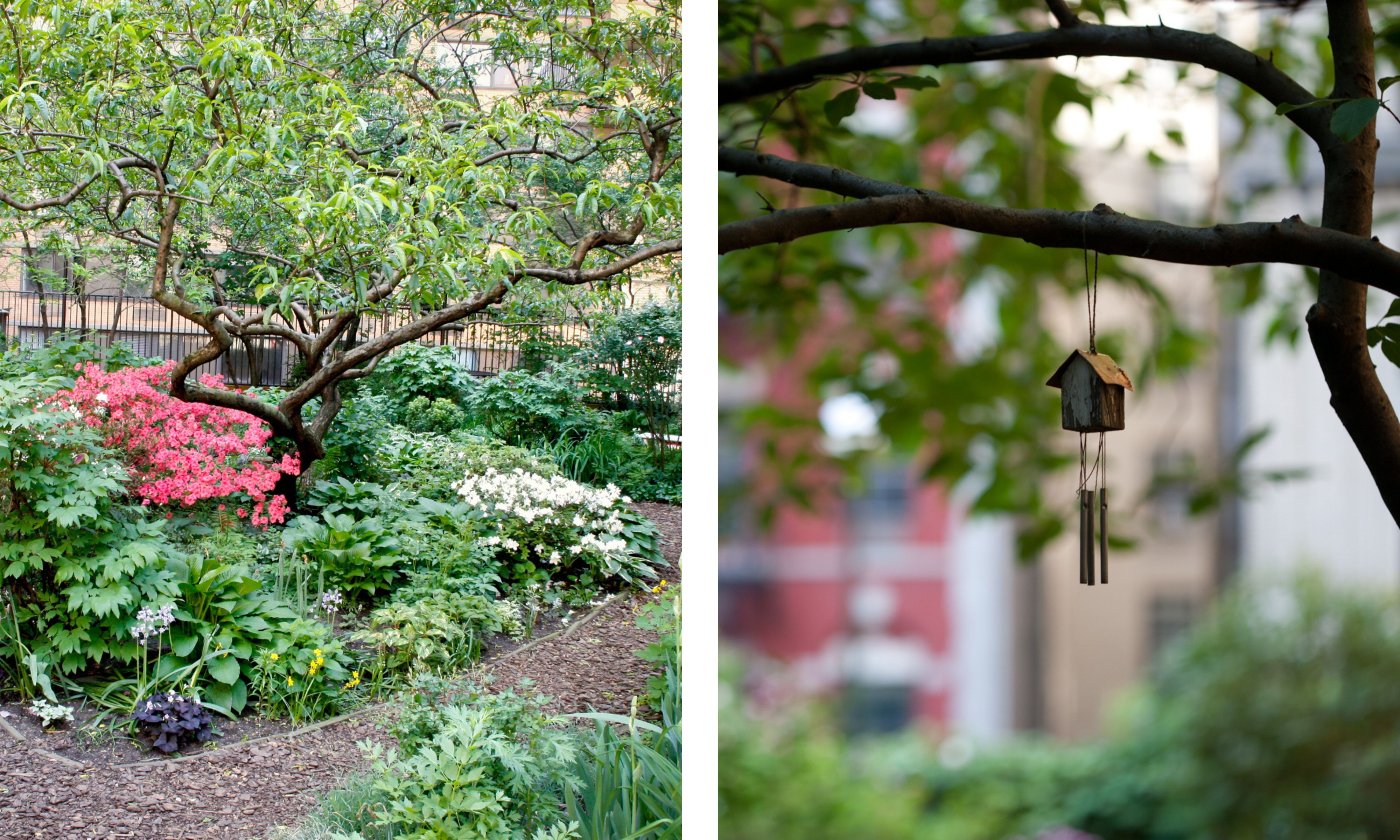
Somewhere urban gardeners can express themselves where they otherwise lack outdoor space
40 years later, the garden sits 20 feet upon a condo garage and provides an escape from the city, without having to leave.
Abundant in woodland planting, flowering climbers, fruit trees, and bright annuals that sit against the backdrop of a concrete jungle, it's a pocket of paradise in the Upper West Side.
But it hasn't always looked how it does now.
This urban garden is constantly evolving at the hands of the individuals who curate it to their own taste, ensuring The Lotus Garden remains made for the community, by the community.
Design expertise in your inbox – from inspiring decorating ideas and beautiful celebrity homes to practical gardening advice and shopping round-ups.
Finally having the room to grow: creating more than just a community garden
Carrie and Mark designed the rooftop garden to be divided into 28 different plots, with each one looked after by a different gardener. Though, you wouldn't be able to spot this division as you wander through the winding paths and observe how the planting effortlessly melts together.
'The plot holders all have different reasons to have joined. There are people who have lived nearby forever and were surprised to discover us here,' says Eve M. Kahn, Co-President of The Lotus Garden.
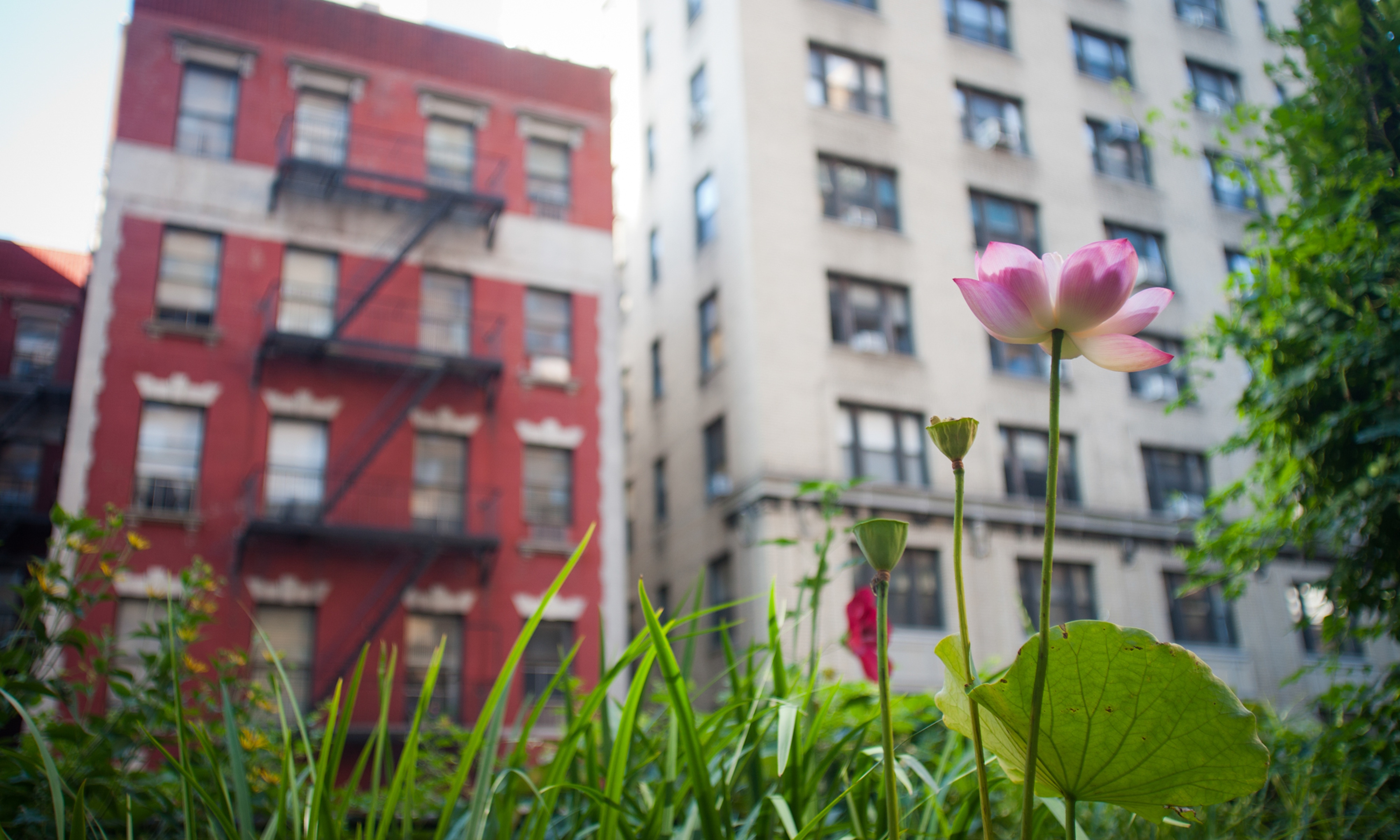
You'll find The Lotus Garden cushioned between city buildings on West 97th Street
'I lived right across the street when the theaters were demolished and watched the garden being built from my window,' says Kenneth Karpel, Treasurer and past President of The Lotus Garden.
'I decided to go over and learn more about the garden. The then-President asked me to plant a Schizophragma hydrangeoides (climbing hydrangea vine) in her plot. I didn't realize this was an audition, but she then offered me the plot where Mark and Carrie had gardened,' he describes.
'It's just such a special place to be, particularly during the Covid-19 pandemic. I was very sick in March 2020, but having the garden to tend to gave me structure to my day and was very healing,' he continues.
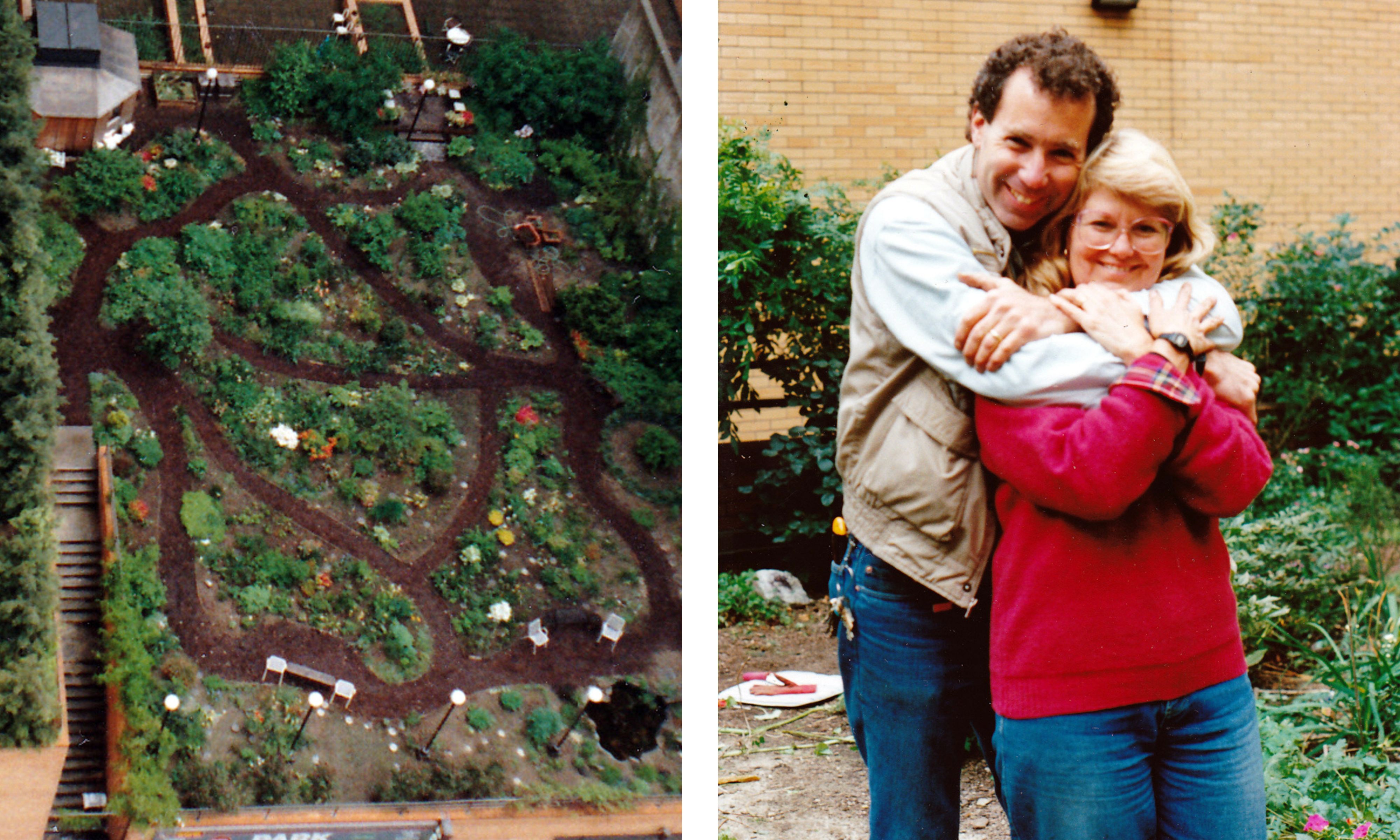
Circa. 1980s, during the creation of The Lotus Garden. To the right: Carrie Maher and Mark Greenwald, creators of the garden
And at 7am, it's a common sight for the peaceful corners of the garden to be occupied by city-goers grabbing a moment of calm with their morning coffee.
'Many of our members choose to work up here or just come to read and enjoy the space because it's a place you can get away from the city and not be bothered,' Karen notes.
The Lotus Garden is also a hub for the wider community, not just its members. Public events and holiday parties are held here, alongside the garden being open every Sunday between April and November. Next year, The Lotus Garden will be the very first NYC garden in The Garden Conservancy's Open Days.
'We get a steady stream of people during those open hours. Many tourists will show up after discovering The Lotus Garden in a random guidebook and often they don't speak English, but we find plants are a universal language that brings them to us,' Eve says.
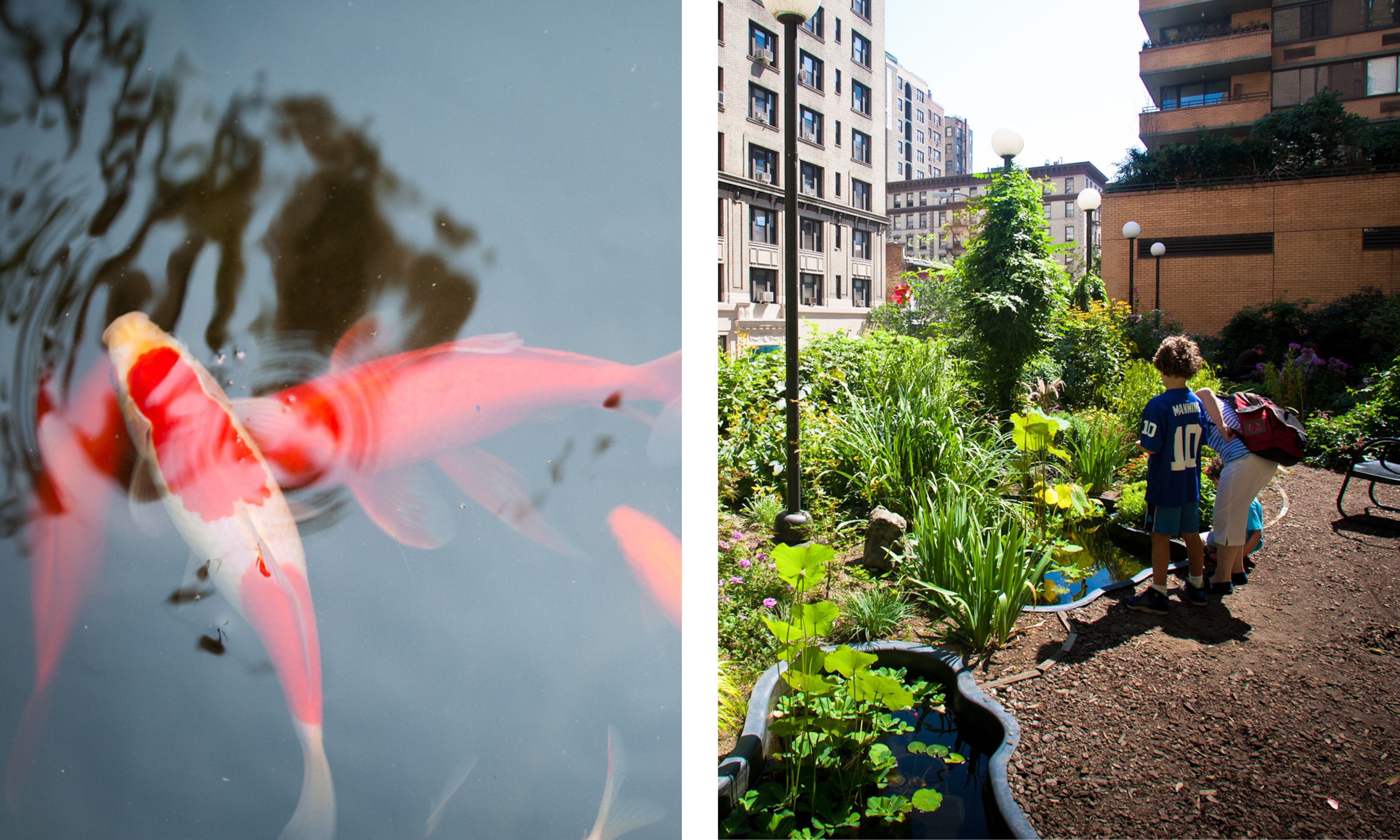
Koi fish live in The Lotus Garden ponds and are cared for by the members
A garden pond that sits in the top left corner of The Lotus Garden is a particular magnet for young families and has proven to be a great way to engage children with gardening.
'We get lots of cute children come along because we have fish that they love to stand at the edge of the pond and admire,' says Eve.
'And many New York City high schools require students to do volunteering hours. So often on Sundays we get teenagers come and help do some gardening. They turn up thinking they're not interested in plants but leave feeling excited about all the things they have learned,' Eve describes. 'They'll help plant bulbs in fall and are ecstatic to see the bright blooms come up in spring.'
It's exactly the space Carrie, Mark, and those founding members first envisioned: a garden for all, to grow plants, to find peace in, to learn from, and to come together to enjoy nature in the middle of the buzzing city.
Making a rooftop oasis possible: planting shaped by people
Much of The Lotus Garden presents a woodland garden scheme, as it's actually part of the Urban Woodlands Community Gardens, a non-profit corporation.
'Because of this, we try to keep it naturalistic-looking, and the plot holders typically have their spaces for years, even decades, so the planting really does look like it's been there forever,' Karen says.

Hostas and ferns make for luscious, shady ground-cover, transporting you out of the city and into a woodland
Walking through the garden, Kenneth describes the trees and shrubs that have been there since the creation of the garden. Many are fruit trees: a peach tree, a quince tree, and even a sour cherry tree. Much of the harvest is shared with visitors who find delight in savouring the freshly plucked fruit, he shares.
In Kenneth's own plot towards the back of the garden, the best shade plants are celebrated. 'I was inspired by a hosta garden in New Hope, Pennsylvania with hundreds of kinds of hostas, so now I have a wide variety of them here,' he explains.
'But, the most beautiful plant in my plot is Corylopsis sinensis, Chinese winter hazel. It has pretty racemes, bright yellow flowers,' Kenneth describes. Russian sage and lots of ferns can also be spotted in his woodland planting plot.
Of course, one of the challenges of an urban rooftop garden is the lack of ground soil. Here, there is just 30 inches of soil to work with, something that has forced the gardeners to make careful planting choices.
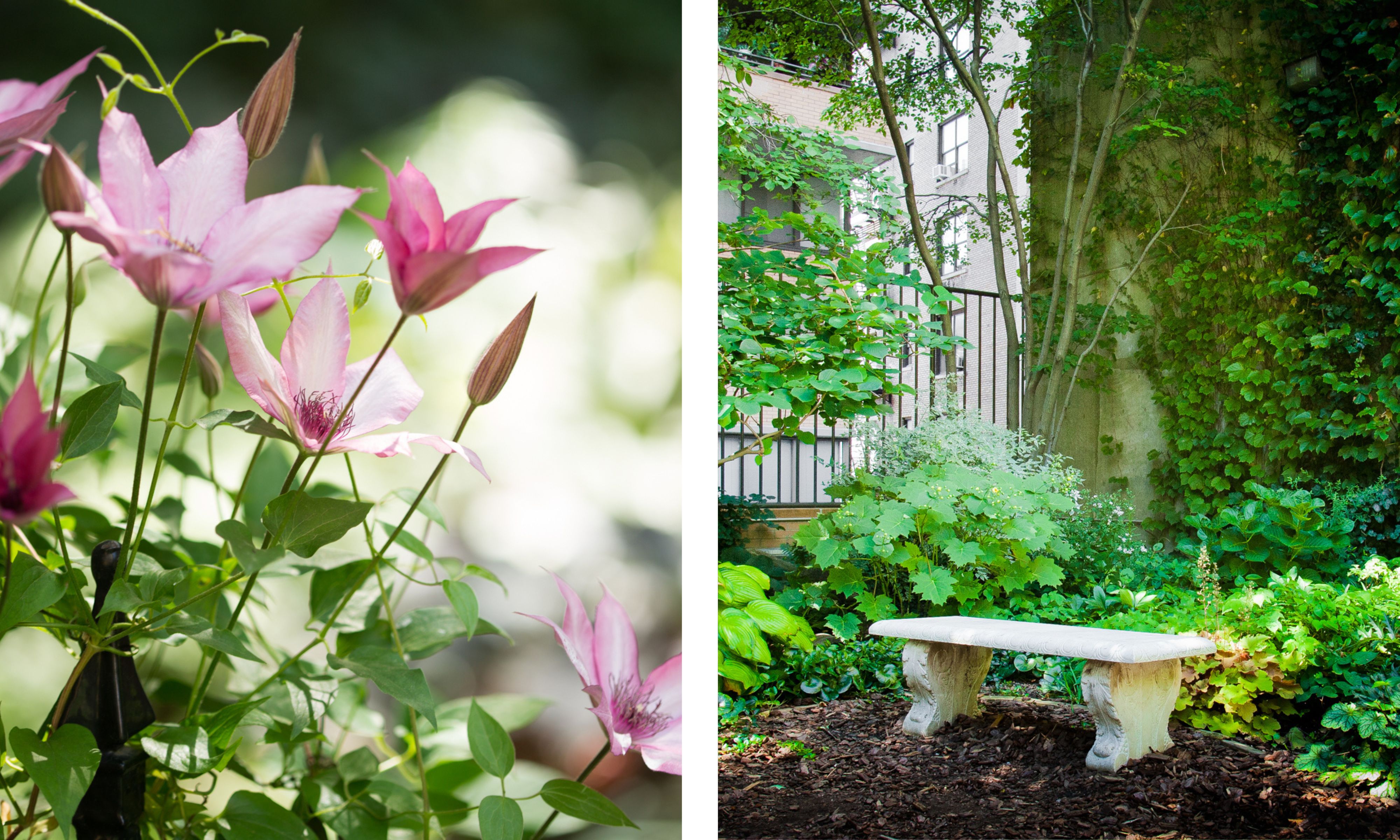
Sunlight breaks through the gaps between buildings, illuminating peaceful seating areas and romantic blooms
Another unique characteristic of The Lotus Garden is the light exposure across the space. While Kenneth's plot is much more shaded, Karen and Eve's plots, which are both towards the front of the garden, receive a fair amount of sunlight, despite the towering neighbouring buildings.
Eve's plot can be found with a sprawling wall of pale purple and white clematis. 'It's put everything else out of business on my plot. It's so healthy,' she describes. 'Karen is three feet from my plot, but she gets a different light pattern than I do with more direct sun.
'Towards the back, there's almost no natural light. There are real microclimates here, it ranges hugely within this tiny space,' she explains.
Something quite beautiful is the way the buildings create shafts of light, placing a spotlight on different parts of the garden throughout the day.
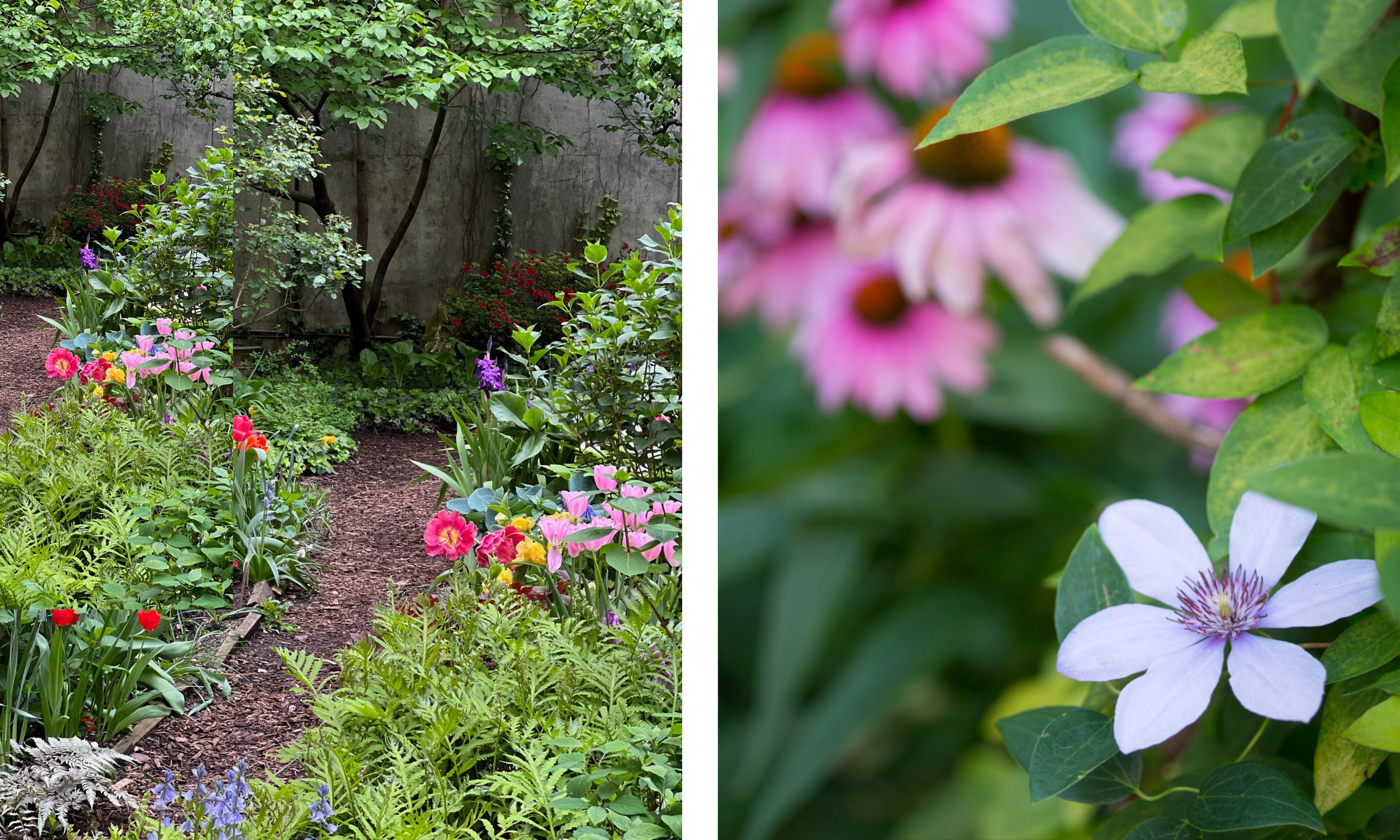
Spring brings an explosion of color in The Lotus Garden
Inward from the walls of the garden, one plot holder has an abundance of zinnias and sunflowers. 'Many of his plants are six to 10 feet tall and add some variation to the garden,' says Eve.
'There are community gardens in New York that are very boxy, but our plots are sort of amoeba-shaped, and you can't really tell the lines between the plots. The only way you can know the actual borders is when a gardener takes you on a tour,' she continues.
With winding garden paths between the unobtrusive plot boundaries, The Lotus Garden has a soft appearance, where everything flows together.
'Our style is much more Gertrude Jekyll than the formal gardens of Versailles,' Eve notes. 'What's amazing is this garden was built and created 41 years ago and the way Carrie and Mark laid it out has held up wonderfully.'
Supporting biodiversity: somewhere plants and wildlife flourish
Not only are the hearts and minds of the people of The Lotus Garden full, it's evident the plants are happy here, too.
'A few months ago, a woman approached me saying she had been struggling to grow a peach tree in her apartment and would like us to adopt it. We accepted the offer and thought we'd just see what happens, although with all leaves yellowing and about to fall off, we weren't too hopeful,' Eve shares. 'Well, it now has about six inches of new growth since living here. It's absolutely incredible what we can achieve with plants in our little garden.'
The Lotus Garden also prioritizes sustainable gardening to keep the plot chemical-free and encourage rich biodiversity.
'If I spot aphids, I simply put gloves on and remove them by hand. I also pick off the slugs one by one and put them in our community compost bin where their work is welcome,' Eve explains.

'Our peach tree is 41 years old, she barely fruits anymore. She's our gorgeous elder stateswoman. But this year, she had two perfect peaches' – Eve M. Kahn, Co-President of The Lotus Garden
The garden is full of plants for pollinators too, with bees and bird life in abundence.
'We get everything from the most ordinary pigeons, to mourning doves, and robins that nest. I once even saw a hummingbird,' Eve shares.
But, having a healthy garden doesn't mean everything has to be perfect all the time. There is plenty of room for error and learning, as this garden proves to be rather forgiving.
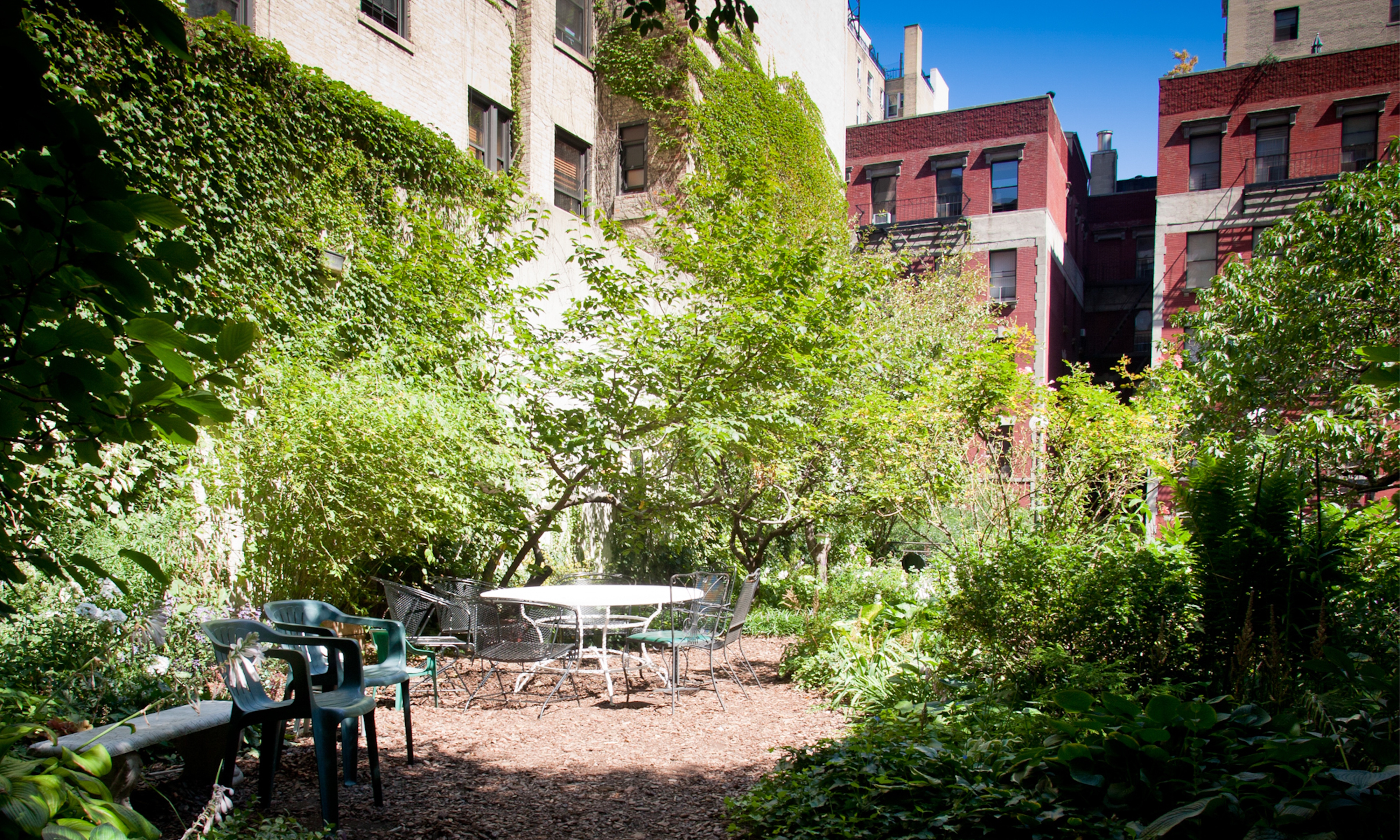
There are quiet pockets throughout The Lotus Garden where people sit and take in the green haven around them
'That's the wonderful thing about The Lotus Garden: you can make a mistake and the scars don't last, it looks untouched,' Kenneth says. 'The garden really is something you don't expect to stumble across among the surrounding buildings, and the bones of it have stood up beautifully.'
'Everyone is so grateful for this space,' says Karen. 'They always thank us and many take it really personally. If something's broken or they see something wrong, they alert us. They treat it as their backyard as well as our backyard, which is really beautiful.'
Ideas to steal from The Lotus Garden
As well as The Lotus Garden being a beautiful space to visit in NYC, there is plenty to be inspired by in this urban garden that can easily be recreated at home:
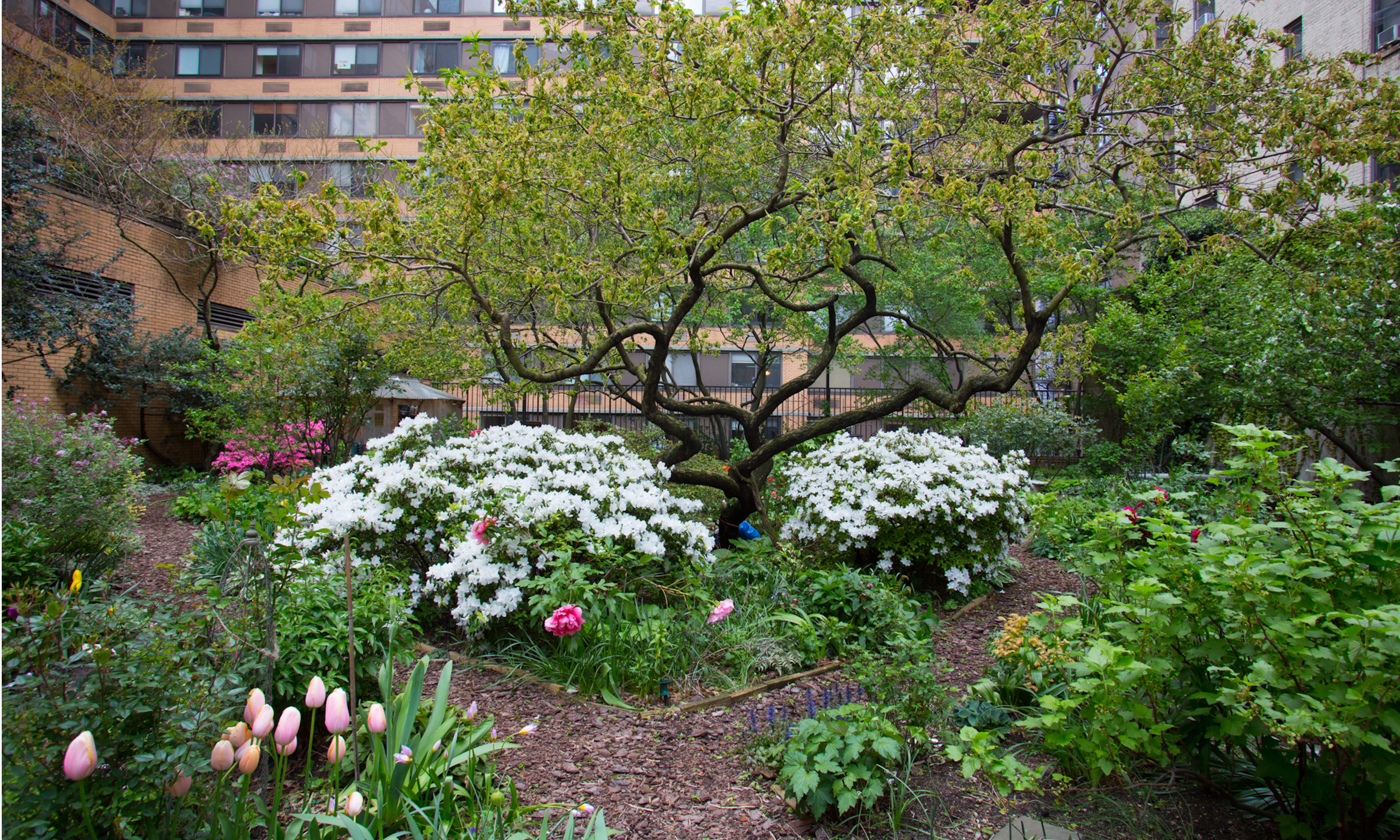
Make the most of shade
For a yard with shady coverage, perhaps from lots of trees, Kenneth's use of ground cover plants for shade is an excellent example of creating a luscious, leafy landscape without needing lots of sun exposure.
Plants such as hostas (see the collection at Nature Hills), ferns, and even shade-loving blooms like cyclamen give you plenty of interest while covering ground that is more challenging for sun-loving plants.
Use planting to elevate seating
There's something to be said for the outdoor seating in this urban garden. The Lotus Garden's tranquil seating is created by placing romantic benches and small tables among planting.
Create a garden room with shrubs to provide some privacy for your seating, allowing you to feel immersed in nature when you retreat there, away from the busyness of everyday life.
Encourage wildlife to bring your garden to life
The simplest of wildlife garden features in The Lotus Garden bring a wide range of birds, bees, butterflies, and more. Having bird houses in trees, a flower bed full of plants for bees, and opting for native planting are easy ways to bring more life to your outdoor space.
Of course, if you wish to have something a bit bigger, The Lotus Garden's fish pond proves to be a joy for all that spend time there.

Karen Gershenhorn, Co-President of The Lotus Garden, is a retired photographic and literary editor, leaving more time for gardening and visiting gardens worldwide. She has been gardening in New York City's Riverside Park for 36 years and The Lotus Garden for 11 years.

Eve M. Kahn, is Co-President of The Lotus Garden board, is an independent scholar, regular New York Times contributor, and biography author.

Kenneth Karpel is a retired architect and former Vice President of Architecture and Engineering at the New York City School Construction Authority. He is the Treasurer and a previous President of the Lotus Garden, where he has been tending his shady plot since 2002.
Beyond Wild Expectations is a new series exploring exceptional public gardens of every scale, from grand formal parterres to intimate community plots. We reveal the design vision, planting choices and defining details that bring the garden to life, and show how each one gives fresh perspectives on how we connect with nature and outdoor living.

Tenielle is a Gardens Content Editor at Homes & Gardens. She holds a qualification in MA Magazine Journalism and has over six years of journalistic experience. Before coming to Homes & Gardens, Tenielle was in the editorial department at the Royal Horticultural Society and worked on The Garden magazine. As our in-house houseplant expert, Tenielle writes on a range of solutions to houseplant problems, as well as other 'how to' guides, inspiring garden projects, and the latest gardening news. When she isn't writing, Tenielle can be found propagating her ever-growing collection of indoor plants, helping others overcome common houseplant pests and diseases, volunteering at a local gardening club, and attending gardening workshops, like a composting masterclass.
You must confirm your public display name before commenting
Please logout and then login again, you will then be prompted to enter your display name.